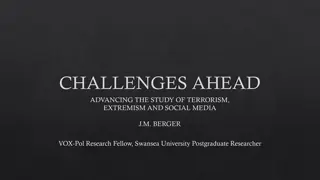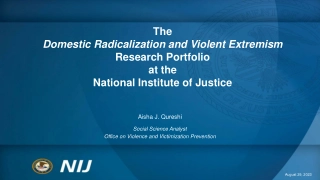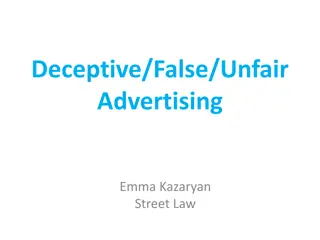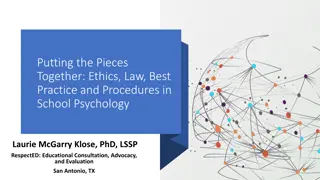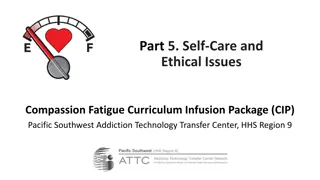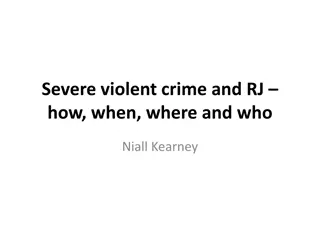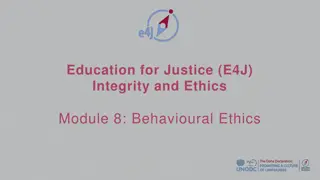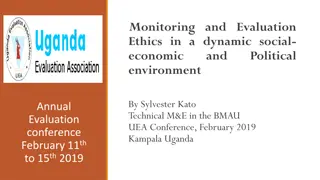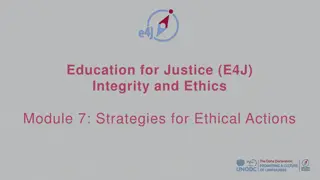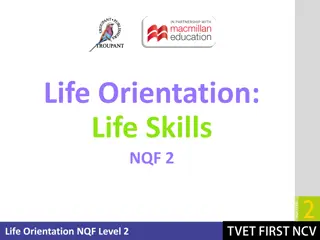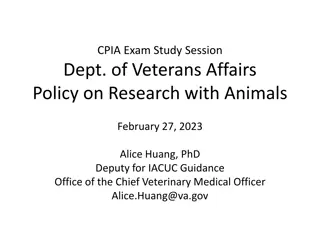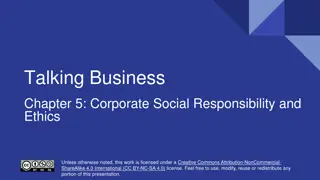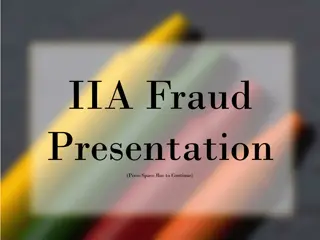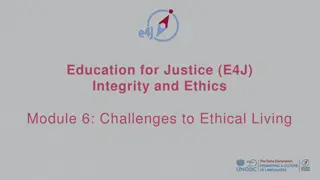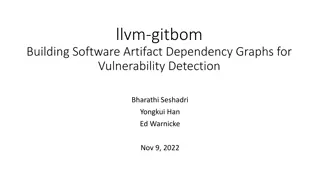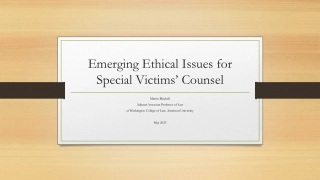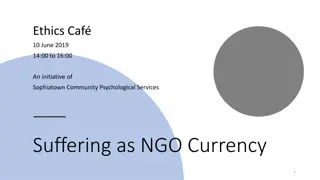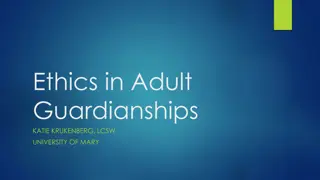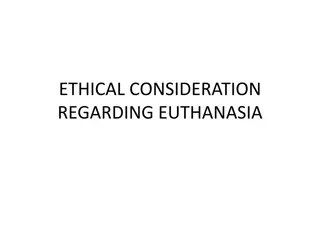Deceptive CVE Strategies and Ethical Considerations in Countering Violent Extremism
Exploring the complexities of implementing online CVE programs to divert youth from violent extremist narratives, this article discusses the use of counter-narratives, ethical challenges of deception, and the importance of reflexivity in program design and implementation.
Download Presentation

Please find below an Image/Link to download the presentation.
The content on the website is provided AS IS for your information and personal use only. It may not be sold, licensed, or shared on other websites without obtaining consent from the author. Download presentation by click this link. If you encounter any issues during the download, it is possible that the publisher has removed the file from their server.
E N D
Presentation Transcript
I lied but it was only for the good of society: The ethics of deceptive CVE Lise Waldek and Julian Droogan Department of Security Studies and Criminology, Macquarie University
Case study: online CVE counter narrative program Engaged on a three-year contract to evaluate a CVE program designed by a not-for-profit organisation Aim: To engage youth populations (14-18 year olds) at risk of migrating towards violent extremist narratives with the purpose of diversion from these narratives and ideologies Program: Online social media platform designed to engaged in person-to-person dialogues with trained youth volunteers. Theoretical basis: Drawing on possibilities of emotional contagion (Kramer, Guilor, Hancock, 2013) and the applicability of dialogue as a means to facilitate ideational transformation FACULTY OF ARTS | DEPARTMENT OF SECURITY STUDIES AND CRIMINOLOGY 5
CVE: from ideas into reality Best practice CVE guidance emphasises the following: - Importance of addressing enabling factors - Identification and engagement in specific target audiences - Integration of evaluation programs/initiatives processes into However, transitioning from policies and guidance into the every-day realities of designing and implementing CVE programs is complex. This is particularly the case in those programs that bridge online and offline environments FACULTY OF ARTS | DEPARTMENT OF SECURITY STUDIES AND CRIMINOLOGY 2
Counter narratives Counter Narratives can be transformative. They can influence a curious individual to move away from violent extremist ideas, concepts, and even networks (Braddock & Morrison, 2018) Effective communication requires dissemination on and through credible and trusted mediums and actors. Interfaces that facilitate person-to-person interaction may increase perceptions of authority and reliability among users. Experiments examining the effect of content manipulation on uninformed users have occurred in the online environment. The Facebook emotional contagion study (Kramer et al. 2014) raised a number of ethical questions over the absence of informed consent and effective de-briefing mechanisms. These questions remain current and unresolved in research that draws on practices that could be classified as deceptive. FACULTY OF ARTS | DEPARTMENT OF SECURITY STUDIES AND CRIMINOLOGY 3
Reflexivity and ethics The uptake of contentious methodological practices including the use of deception demands an ethically robust process during the program design and implementation. The case study under examination today highlights how implementation of programs that have been through rigorous procedural ethic reviews generate novel and unknown challenges. These support the adoption of a reflexive ongoing ethical processual framework (Guillemin, Marily, & Gillam, 2004). Incorporating processes of reflexivity will facilitate the ongoing scrutiny of practice and any resulting knowledge constructions (McGraw, Zvonkovic and Walker 2000: 68); this in turn will increase the effectiveness of the evaluation process, the impact of the CVE program and the maintenance of appropriate ethical guidance. FACULTY OF ARTS | DEPARTMENT OF SECURITY STUDIES AND CRIMINOLOGY 4
Manipulationdeception The program design included two activities that meet the definitions of active and passive deception as defined by Kimmel, Smith & Klein (2011, p.225): - Active Deception being defined as, deception by commission, when a researcher blatantly misleads participants about some aspect of the investigation Passive Deception being defined as, Passive deception is by omission, when a researcher purposely withholds relevant information - The program deception emerged from two core design functions: 1. The online social media platform was designed to blur into the violent extremist environment. Closer inspection revealed this deception to be relatively thin . 2. Volunteer access to the social media platform occurred through a number of fake accounts FACULTY OF ARTS | DEPARTMENT OF SECURITY STUDIES AND CRIMINOLOGY 6
Justifications: reach Facilitation of access to hard to reach online target audiences The evaluation of the first year of the program indicates the deception was successful in engaging with a previously identified challenging or hidden target audience The perceived shallow nature of the deception that allowed for users to quickly identify the non-violent extremist agenda of the content posted on the social media platform was judged to mitigate the negative associations of the initial deception akin to a white-lie Review of individual comments found 1% were concerned about recommendations towards this social media platform site, despite the apparent shallow status of the site The inability to debrief participants meant the ramifications of the deception and the outing of the platform s objectives remain unknown FACULTY OF ARTS | DEPARTMENT OF SECURITY STUDIES AND CRIMINOLOGY 7
Justifications: safety The provision and use of fake accounts provided the volunteers online and offline protection, essentially ensuring anonymity during their engagement in the program The insertion of youth volunteers into an online environment engaging with violent extremist ideologies involves significant duty-of-care responsibilities and ethical considerations: - Bespoke training program focused on practical behavioural instruction delivered to all volunteers Supervision by trained and experienced youth counsellor Generation of peer-to-peer volunteer network - - Provision of fake account provided a useful barrier for volunteers to facilitate engagement and protect against personalising the experiences/ dialogues FACULTY OF ARTS | DEPARTMENT OF SECURITY STUDIES AND CRIMINOLOGY 8
Justifications: trust Numerous studies on CVE emphasise the importance of generating and maintaining trust between the propagators and the targets of a given strategy or narrative This raises the question on the impact of a CVE program that includes an intentional effort to mislead, an action that is one of the most common reasons for generating mistrust (Bok 1978, 1992) Effective community engagement needs to be built on a foundation of trust .actions can speak lounder than words and when groups see authorities acting in ways that are contrary to their professed statements ,trust can be easily lost (Cherney & Hartley, 2017) FACULTY OF ARTS | DEPARTMENT OF SECURITY STUDIES AND CRIMINOLOGY 9
Impact, effect and ethical reflexivity Responding reflexively to these ethical challenges involves a process of ongoing evaluation The inclusion of a milestone evaluation in the program is a useful way to re-address the risk/balance decision making that occurred at the outset of the program The evaluation examined the impact and effectiveness of the online dialogues against the program s theory of change (identified in the program design stage) The online dialogues were scrapped and subjected to sentiment analysis to test and measure the extent to which the interactions / interventions facilitated the target audience to engage with the volunteers, critically reconsider involvement with violent extremist narratives and construct forms of identity and social belonging that draw on non-violent extremist rhetoric FACULTY OF ARTS | DEPARTMENT OF SECURITY STUDIES AND CRIMINOLOGY 10
Impact, effect and ethical reflexivity Collectively, all four of the sample conversations produce positive indicators that quantitatively outweigh the negative indicators This indicates that volunteers have been able to engage in debate and potentially facilitate processes of disengagement However, there were challenges: - Methodologically, the negative indicator non-engagement proved challenging to code using the NVivo method. Several subjects refused to answer certain questions or just broke the conversation with the volunteers - The relative lack of evidence for meaningful engagement by the subjects as indicated by an unwillingness for the subjects to ask questions of the volunteers - Dialogues are mostly one-sided. While the volunteers are actively asking questions, the subjects are not in turn asking questions of the volunteers, but instead expressing their own views and opinions These results suggest the subjects interacted in line with processes of individuation and the echo chamber effect. FACULTY OF ARTS | DEPARTMENT OF SECURITY STUDIES AND CRIMINOLOGY 11
Conclusion: addressing ethics through reflexivity The case study was somewhat successful in engaging with hiddenaudiences and cultivating dialogues Successful intervention to divert subjects away form extremist ideology was only achieved in limited fashion Deeper evaluation would necessitate active monitoring of subjects without consent on additional social media platforms A reflexive ethical process emerged from the ongoing evaluation embedded into this CVE program. It allowed for the formation of recommendations that move the focus of the program away from the deceptive elements, to focus on other aspects of the program such as the formation of volunteer peer-to-peer support groups These online social networks of supportive trained volunteers can potentially engage more confidentially in honest online and offline dialogues that foster counter narratives and CVE FACULTY OF ARTS | DEPARTMENT OF SECURITY STUDIES AND CRIMINOLOGY 12



